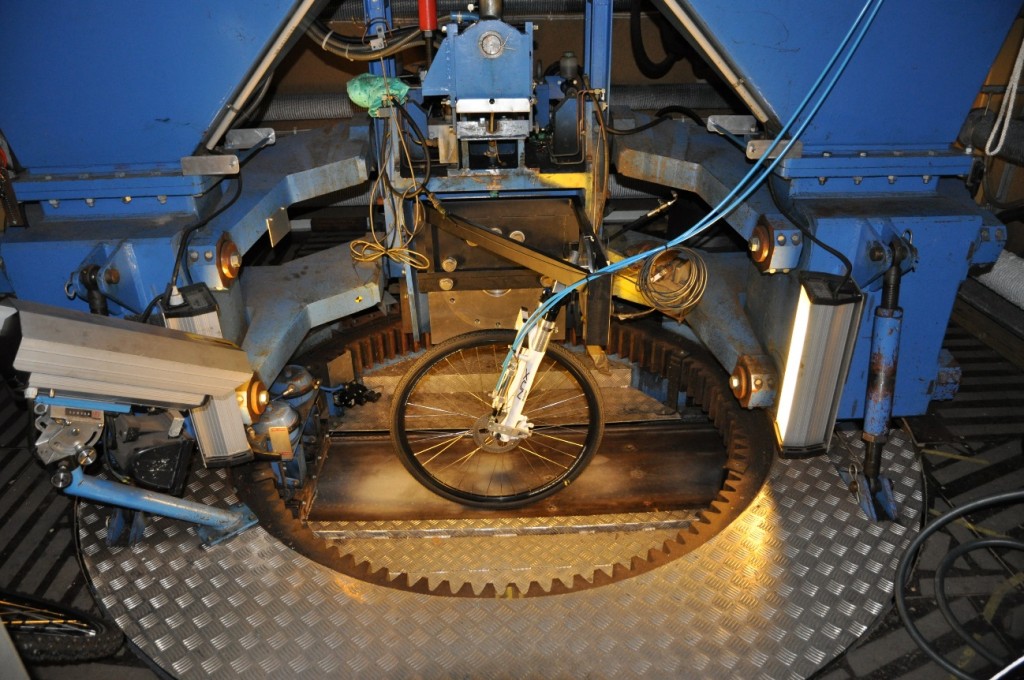Traffic safety during cycling is as timely as it is important. Several cycling-related research projects are underway at the Swedish National Road and Transport Research Institute (VTI), and one group of researchers recently developed a method for testing the grip of various bicycle tyres on ice. Initial tests indicate that studded bicycle tyres generally grip ice better than do non-studded tyres, and that there are major differences between different studded tyres.
VTI has a stationary tyre test facility consisting of a moving track with a drive system and a measurement rig with a stationary but pivotable wheel mounting. This design makes it possible to measure both the braking and steering forces of a rolling wheel under controlled conditions:
“We have previously tested both lorry tyres and car tyres using VTI’s tyre test facility, but several modifications were necessary before we could begin testing bicycle tyres. For instance, the wheel mounting, pulsimeter, and brake device had to be redesigned”, says VTI researcher Mattias Hjort.
The aim of the project has been to develop a test method for determining the grip achieved by different types of bicycle tyres on ice, and to conduct initial tests of several different tyres.
“One long-term goal is to be able, using the test method, contribute to the development of better tyres and to provide underlying documentation for information campaigns about studded bicycle tyres targeting winter cyclists”, says project manager and VTI researcher Anna Niska.
Different types of ice friction can be tested
In the first study using the test method, the researchers measured the ability of bicycle tyres to grip the road on smooth ice on a flat underlying surface. Four different studded tyres for bicycles were compared with two regular summer tyres, all measuring 28 inches.
“The extent of the differences in road grip measured for different tyres is heavily dependent on the properties of the ice. Ice with the same properties can be produced day after day in our tyre test facility, so that ice friction measurements for different tyres can be compared for a certain type of ice”, Hjort explains.
Some of the conclusions drawn from the measurements made so far are as follows:
- Studded tyres generally grip ice better than do non-studded tyres.
- Studded tyres have considerably higher braking stability than do non-studded tyres, positively affecting the overall stability of the bicycle when braking on ice.
- There can be major differences in ice grip between different studded tyres, but all tested tyres performed better than did non-studded bicycle tyres.
- When braking with a locked wheel, the researchers measured up to 2.5 times more friction with studded tyres than with the non-studded reference tyre. The braking distance is then just over half as far, and it is possible to apply 2.5 times more force to the brake without skidding.
- More studs do not necessarily mean better ice grip: the rubber mixture and stud conformation also appear to have a major effect on ice grip.
Studded tyres recommended
The new method works well in comparative testing, and only a few tests have been carried out so far. More comprehensive studies involving different tyre pressures, more types of studded tyres, non-studded winter tyres, aged tyres, non-studded tyres made of different rubber mixtures, etc., are needed to be able to draw more general conclusions about the significance of various parameters that affect bicycle tyre road grip. Based on the results obtained so far, recommending that cyclists use studded tyres when cycling on winter roads clearly has merit.
The project is financed by the research fund of Länsförsäkringar Alliance.
Text: Katarina Nestor
Report:
VTI Report 862: Can studded tyres reduce the number of single bicycle accidents? Friction measurements of bicycle tyres in the VTI tyre test facility
Authors: Mattias Hjort, Anna Niska
Link to full report (in Swedish with a summary in English)
 Contact: Contact:Mattias Hjort mattias.hjort@vti.se VTI, Sweden |







Follow us: